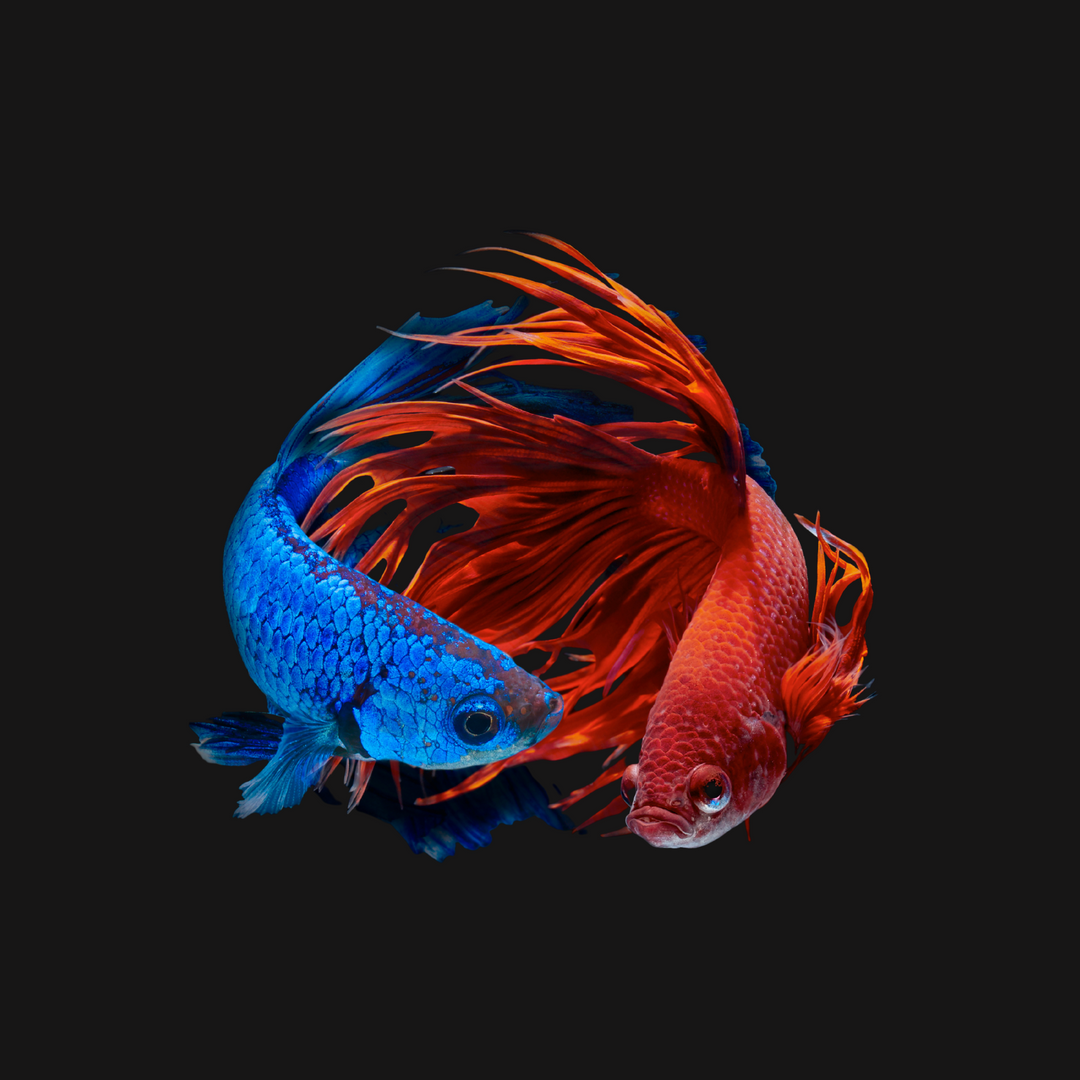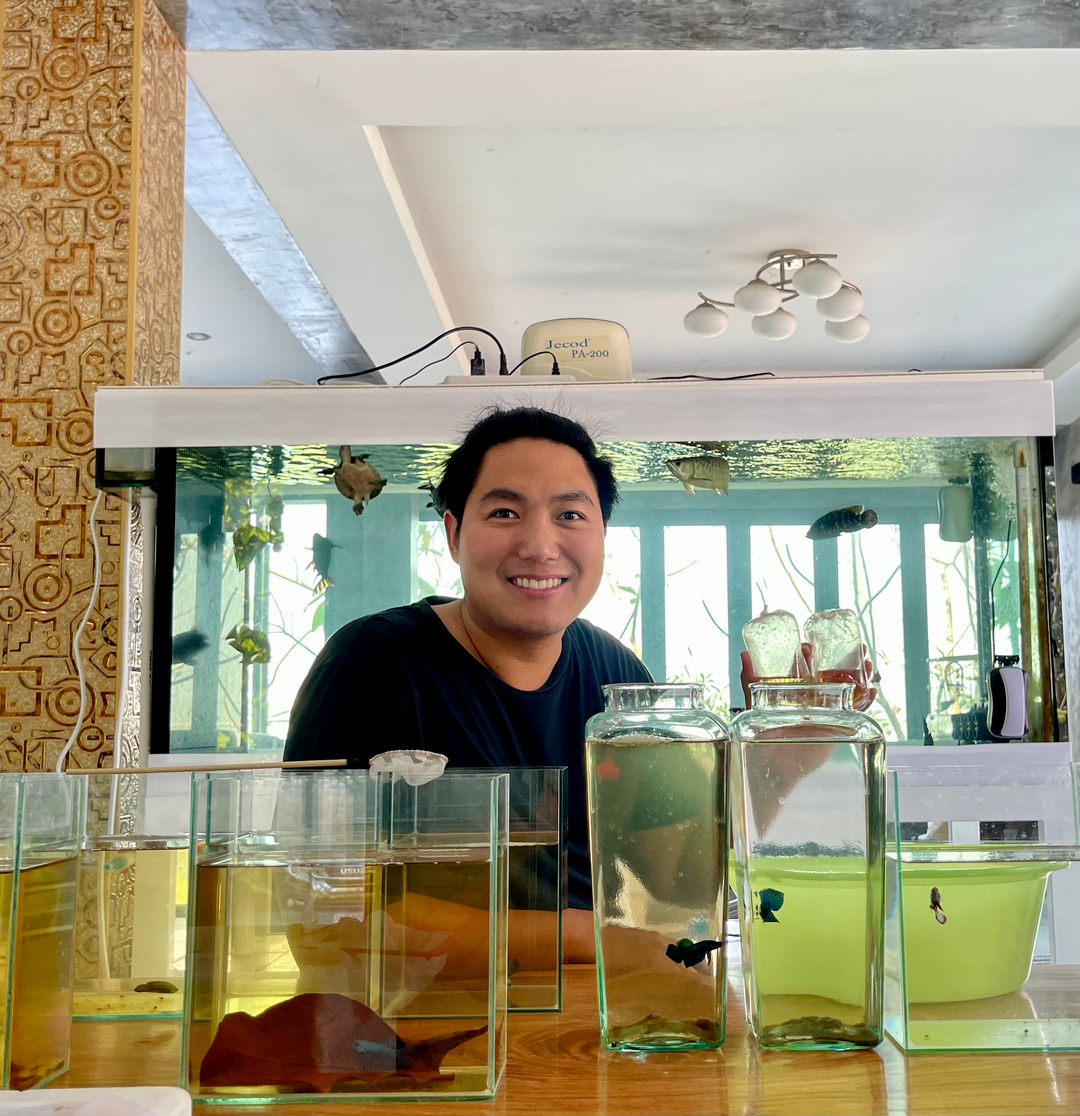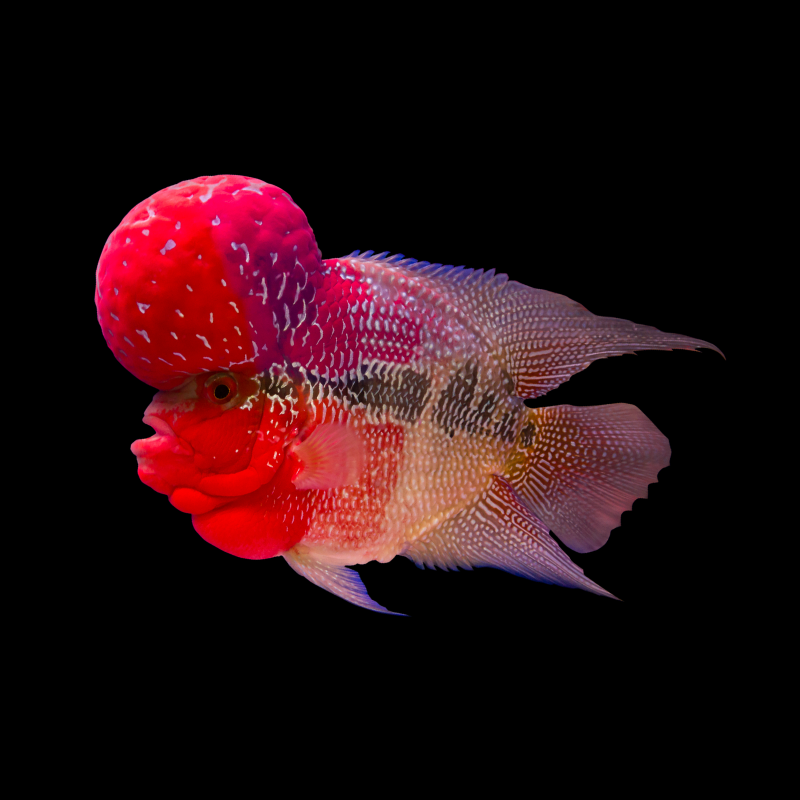
Red Dragon Flowerhorn
Welcome to the world of Red Dragon Flowerhorns, where each fish tells a story of passion and precision breeding. Our collection showcases everything from classic red dragon flowerhorn specimens to the prestigious Super Red Dragon (SRD) variety. These remarkable fish bring more than just stunning looks to your aquarium – they're intelligent, interactive pets with personalities as bold as their colors. Discover why enthusiasts worldwide consider these magnificent creatures the crown jewels of the aquarium hobby.
About Red Dragon Flowerhorn
The question of what makes Red Dragon Flowerhorns unique is one that every enthusiast should understand. These magnificent fish stand apart through their intense, uniform red coloration that covers the entire body. Unlike other red varieties, true Red Dragons display this coloration from an early age, with the intensity deepening as they mature. Their red hue isn't just a surface color – it penetrates deep into their scales, creating a three-dimensional effect that makes them truly mesmerizing.
Super Red Dragon Flowerhorns represent the pinnacle of red coloration in the flowerhorn world. They exhibit a deeper, more intense shade of red with exceptional color stability. SRDs also tend to develop more pronounced head growth and typically show better muscle definition. Think of them as the premium edition of an already exceptional fish – every characteristic is enhanced, from color intensity to overall form.
When it comes to red dragon flowerhorn fish price considerations, several factors come into play. The intensity and uniformity of the red coloration significantly impact value, with pure, deep reds commanding premium prices. SRD specimens typically cost more due to their enhanced characteristics. Age, size, head growth, and genetic lineage also influence pricing. Quality adult specimens can be a significant investment, reflecting their status as show-quality fish.
The various red dragon flowerhorn types showcase the diversity within this prestigious line. Beyond the standard Red Dragon and SRD, you'll find variants like the Short Body Red Dragon, which displays the same intense coloration in a more compact form. Some specimens may show subtle variations in red hues, from deep crimson to bright ruby, each with its own unique appeal. Genetic background plays a crucial role in determining these variations.
Understanding red dragon flowerhorn max size is crucial for proper care planning. These impressive fish typically reach 10-12 inches when fully grown, with some exceptional specimens growing even larger. Males generally grow larger than females and develop more pronounced head growth. The growth rate is influenced by genetics, diet, and living conditions, with optimal care leading to better development.
Show-quality specimens must meet demanding standards. The red coloration should be intense, uniform, and stable throughout the body. Head growth should be proportional and well-developed, especially in males. Body shape must show proper proportion and strong muscle development. Fins should be perfect, without tears or deformities. The overall appearance should be commanding, with the fish displaying confident bearing and active behavior.
Authenticity in Red Dragon Flowerhorns can be verified through several key indicators. True Red Dragons show their characteristic coloration from a young age, unlike some red varieties that develop color later. They should come with documentation of their breeding history from reputable sources. The color intensity and distribution should be consistent with known Red Dragon patterns, and the fish should display typical behavioral characteristics of the variety. Reputed breeders do this for you.
A red dragon flowerhorn full grown specimen is truly a sight to behold. At maturity, these fish display their most intense coloration, fully developed head growth, and impressive size. Their personality becomes more pronounced, and they often develop strong bonds with their keepers. Full-grown specimens showcase the true potential of their genetics, making them particularly valuable for breeding programs and show purposes.
Color development in Red Dragons is a fascinating process. Unlike some flowerhorn varieties that change dramatically as they age, Red Dragons show their characteristic red coloration from an early stage. The intensity deepens with age, and under proper care, they maintain this coloration throughout their lives. Diet, water conditions, and stress levels can all impact color intensity, making proper care crucial for optimal development.
Healthy specimens display several clear indicators. The red coloration should be bright and uniform, without patches or fading. Movement should be confident and purposeful, with fins fully extended. Appetite should be strong and consistent. The fish should be responsive to its environment and show typical territorial behavior. Regular interaction with keepers and active swimming patterns are also positive signs of good health.
Our Legacy
We work tirelessly for 30 years to uphold the high standards set by our Thai ancestors and fellow breeders, ensuring that each and every Betta Fish for sale we produce is of the highest premium quality and meets the expectations of our customers. When you buy live betta fish online from us, you're not just purchasing a beautiful and captivating pet. You're also becoming a part of a long and rich history, and joining a community of people who appreciate and value the beauty and wonder of these amazing Betta Fish.
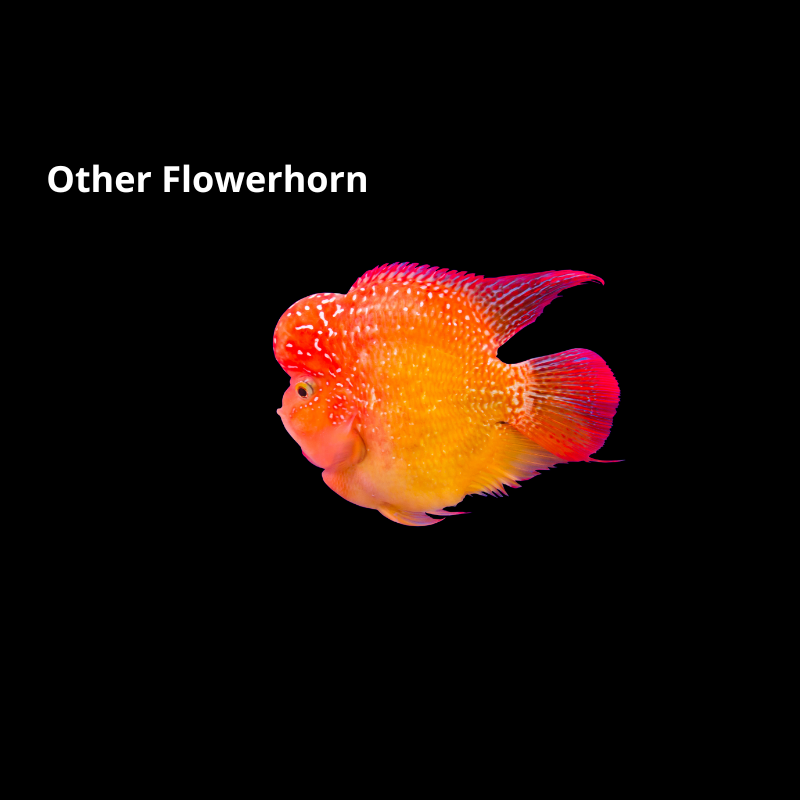
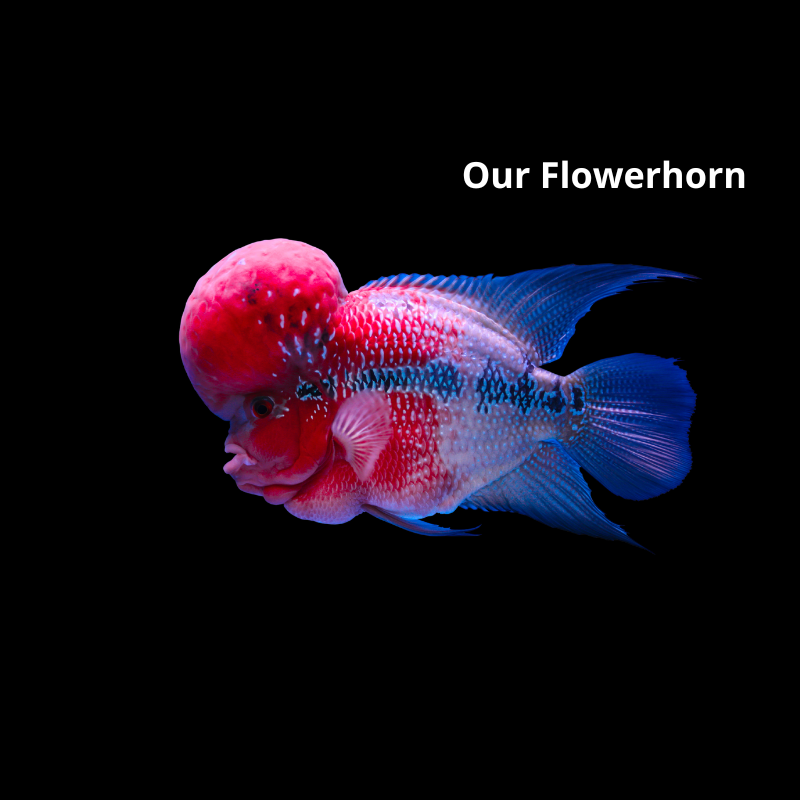
Red Dragon Flowerhorn Care
The red dragon flowerhorn lifespan typically ranges from 10-12 years with proper care. This longevity depends heavily on genetics, diet, water quality, and overall care conditions. Some specimens have been known to live even longer under optimal conditions. Regular health monitoring, proper nutrition, and stress-free living conditions are key to maximizing their lifespan.
Many enthusiasts ask about the specific tank setup required for Red Dragon Flowerhorns, and the answer emphasizes both space and quality. These prestigious fish need a minimum of 75 gallons, though 100+ gallons is ideal for optimal color development and growth. The aquarium should be longer rather than taller, with a width of at least 18 inches to accommodate their turning radius. Substrate should be smooth to prevent scale damage, and decorations should be minimal to provide maximum swimming space and reduce territorial behaviors.
Maintaining optimal color intensity in Red Dragons is one of the most common concerns among keepers, and it requires a multi-faceted approach. Water quality is paramount – maintain pristine conditions with ammonia and nitrites at zero, and nitrates below 10ppm. Temperature stability between 82-84°F promotes optimal color expression. Lighting should be moderate but consistent, with a regular photoperiod of 8-10 hours daily. Most importantly, feed a varied diet rich in natural color enhancers like krill, spirulina, and astaxanthin to maintain that signature deep red coloration.
The question of establishing the best feeding schedule for Red Dragon development comes up frequently among serious keepers. A proper feeding regimen requires 2-3 meals daily for adults, with portions they can consume within 2-3 minutes. The diet should be primarily high-quality pellets (40-45% protein) supplemented with fresh foods like krill, bloodworms, and mysis shrimp. Color-enhancing foods should make up at least 30% of their diet. For maximum benefit, alternate between different food types and include vitamin-enriched options.
Success with Red Dragons relies heavily on maintaining precise water parameters. Temperature should be stable at 82-84°F, with pH between 7.0-7.5. General hardness should range from 8-12 dGH. Weekly water changes of 30-40% are essential, using properly conditioned water matched exactly to tank parameters. Regular testing for ammonia, nitrites, and nitrates is crucial, with special attention to maintaining stability rather than chasing "perfect" numbers.
The management of stress in Red Dragon Flowerhorns is a critical aspect of their care that directly affects both color intensity and overall health. Whether you're an experienced keeper or new to these magnificent fish, understanding stress management is essential. Maintain consistent feeding schedules and water parameters. Avoid sudden changes in lighting or tank arrangement. If using mirrors for stimulation, limit sessions to 5-10 minutes twice daily. Create defined territories with carefully placed decorations while maintaining open swimming areas. Regular observation helps identify and address stress triggers before they impact health.
When considering what filtration system best supports Red Dragon color development, several factors come into play. Install a canister filter rated for at least three times the tank volume, incorporating mechanical, biological, and chemical filtration stages. Include activated carbon to remove dissolved organics that can dull coloration. UV sterilization can help prevent parasitic infections that might affect color quality. Ensure good surface agitation while maintaining moderate flow in the main tank area.
Red Dragons require vigilant health monitoring with special attention to color-related issues. Watch for any fading or patchy coloration, which often indicates stress or health problems. Monitor for signs of hole-in-the-head disease, which can be more visible against their red coloration. Check regularly for parasitic infections that can affect scale quality and color integrity. Any rapid color changes should be investigated immediately as they often indicate underlying health issues.
Careful acclimation is crucial for these sensitive fish. Use a drip method over 2-3 hours to slowly match water parameters. Keep lights dim during the first 48 hours to reduce stress. Monitor behavior closely, looking for normal swimming patterns and responsiveness. Don't feed for the first 24 hours, then start with small amounts of high-quality food. Watch for color stability during the acclimation period, as stress can cause temporary color fading.
Red dragon flowerhorn cichlids can be highly territorial, requiring specific management strategies. Provide adequate swimming space and carefully positioned sight breaks using decorations. If using tank mates (which is generally not recommended), choose species that occupy different water columns. Regular feeding schedules help reduce aggression, as does maintaining optimal water conditions. Monitor behavior patterns to identify and address triggers of excessive aggression.
Breeding these premium fish requires exacting conditions. Maintain slightly warmer temperatures (84-86°F) and impeccable water quality. Condition breeding pairs with high-protein foods rich in natural color enhancers. Provide broad, flat surfaces for egg laying and ensure perfect water parameters through additional filtration and frequent water changes. Success often depends on careful matching of compatible genetic lines to maintain color quality.
Maximizing growth while maintaining color quality requires a balanced approach. Feed high-quality foods 3-4 times daily for juveniles, reducing to 2-3 times for adults. Maintain larger than minimum tank sizes to promote activity and muscle development. Regular water changes (30-40% weekly) help remove growth-inhibiting hormones. Document growth through photos and measurements to track development patterns.
Proper lighting is crucial for showcasing and maintaining their signature red coloration. Use full-spectrum LED lighting that enhances red hues without causing stress. Maintain a consistent photoperiod of 8-10 hours daily, using gradual transition periods. Position lights to minimize reflection on tank walls while providing even illumination. Consider seasonal light cycle adjustments to mimic natural conditions.
Show preparation requires intensive care and attention to detail. Increase water change frequency to maintain perfect clarity and color expression. Fine-tune diet with additional color enhancers 2-3 weeks before showing. Practice controlled mirror training to enhance muscle tone and bearing. Transport in well-insulated containers with stability aids to prevent stress-related color fading during travel.
Establish a comprehensive maintenance routine for optimal results. Perform 30-40% water changes weekly, with filter maintenance every 2-3 weeks. Deep clean substrate monthly while maintaining biological filtration. Test water parameters twice weekly, keeping detailed records. Schedule regular health checks and photo documentation to track development and address any issues promptly.


